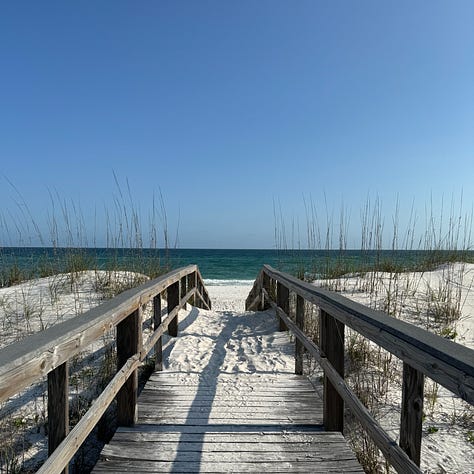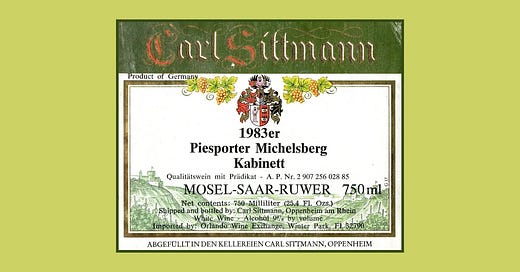Breaking down German wine labels
🇩🇪 It’s a pretty no-nonsense system, even if you don’t sprichen sie Deutsch
Sorry for the quiet April, the month really got away from me. Between my birthday, a beach trip, and the cherry blossoms blooming (I went to the botanical gardens a casual 12 times), there was apparently no time for writing. I did drink plenty of wine though, so let’s catch up.
Read till the end for a bonus list of my favorite (non-wine) things from the month.






I’m naming May the month of the Mosel Valley — riesling’s aromatic citrus, green apple, and floral notes are the perfect pairing for the delicate flavors of spring produce. Fresh herbs, bright green salads, and crisp seasonal veg really shine with a racy, acidic riesling. It’s like that final squeeze of lemon to finish a dish.
But before we jump in, I think we need a primer on German wine labels. It’s a complicated system full of long, funny sounding words (why so many consonants?). But, like most things German, it is organized and logical, so once you get the hang of it, you’ll be ordering Kabinett Trocken wines like a pro.
Trockenbeerenauslese? That one might take a bit more practice.
Why are German labels so detailed?
German labels are packed with information because of the diversity of wines, especially riesling. This grape is known for being an incredibly terroir driven grape, highly influenced and impacted by the specific site it is grown, and can produce wines ranging from bone dry to very sweet. Its distinct bracing acidity and high sugar content gives winemakers much more flexibility than many other grape varieties. It’s also why sommeliers are obsessed with riesling. The range of this grape really keeps things interesting.
What’s so unique about the label?
Most information will be familiar — region, grape variety, producer. We did a whole post on this, in case you need a refresher:
But unique to German labels is information about grape ripeness and wine sweetness.
Ripeness: Sugar content of grapes at harvest.
Sweetness: Sugar remaining after fermentation. Dry wines ferment until all the sugar has been converted to alcohol.
These were introduced in the 1970’s when Germany overhauled their wine laws. In an attempt to create a more egalitarian wine system, Germany removed site specific labels, opting instead to highlight these two traits in the wine. In theory, this means any winemaker in German is capable of creating the highest quality wine, not just the lucky winemakers who had the fortune of inheriting a prestige vineyard site. A not so subtle swipe at France, it seems.
Too much! Just tell me how to find the dry riesling!!
Want dry wine without reading my German wine novel? Just look for the words Trocken, meaning “dry”, or Grosses Gewächs (GG), the top tier of dry riesling, on the label. Both of these will always be fully dry wines.
Quality categories
German wines are classified into quality levels, similar to France’s AOC or Italy’s DOCG:
Deutscher Wein: Table wine.
Landwein: Regional wine.
Qualitätswein: Quality wine from one of 13 regions.
Prädikatswein: Top quality with specific attributes like ripeness and harvest method. Prädikatswein translates as "predicate wine" because the wine must be labeled with a "predicate," indicating grape ripeness.
Unlike other wine-growing countries, only small quantities of lower level wine are produced, rarely making it outside of the country. Most German wines found in the U.S. are Qualitätswein or Prädikatswein.
Dryness levels
Typically riper grapes means sweeter wines. Think of a jammy California Zinfandel — the hot climate and consistent sun creates sweet, very ripe grapes. But riper grapes do not have to make sweet wines. After the grapes are picked and pressed, yeast easts the sugar, fermenting the wine and creating alcohol. This gives winemakers the ability to determine how dry to make a wine, regardless of how ripe the grape was at harvest.
Not seeing any of these terms on the bottle?
Check the alcohol level (ABV) on the back label. Higher ABV means less sugar: 12% usually means dry, 10% off-dry, and 8% or lower will be sweet
Ripeness
Grape ripeness is something that German winemakers can’t take for granted. Located at the northern limit of wine producing regions, poor weather often prevents grapes from fully ripening. Because of this, ripeness is an especially prized trait associated with the highest quality wines.
The first 3 ripeness levels can be used to make dry or sweet wines (more on that shortly!)
Kabinett
Grapes picked at normal harvest timeFun fact: Kabinett literally means “cabinet” in English. This term likely comes from winemakers indicating these were high quality wines worthy of setting aside or storing for their own consumption.
Spätlese: “Late harvest”
Riper grapes picked later in the harvest, richer and more complex wines, able to age for longer periods of time.Auslese: “Select harvest”
Hand-selected grape bunches that were ripening extremely well, intense, concentrated, complex, & usually sweet wine.



The next 3 ripeness levels will always result in a sweet wine. These designations are rare, requiring perfect weather conditions for grapes to ripen to these levels.
Beerenauslese: “Berry select harvest”
Individually selected, hand harvested, overripe berries.Trockenbeerenauslese: “Dry berry select harvest”
Hand harvested, grapes dried up almost like raisins.The “Trocken” prefacing Trockenbeerenauslese (confusingly) refers to the grapes being dry when they are harvested. Not to be confused with the appended term that refers to the sweetness of a wine.
Eiswein: “ice wine”
Grapes frozen on the vine, harvested and immediately pressed.
But wait, there’s more!
You probably thinking, wow ok, that’s complicated but I think I got it. And to that, I say….unfortunately we’re not quite done.
Enter VDP — or Verband Deutscher Prädikatsweingüter — an exclusive, invite only group of about 200 top producers that operates outside of the official governmental wine laws. Marked by the (very German looking) eagle with grape bunch crest, The VDP emphasizes the importance of terroir in German wines, incorporating vineyard-specific quality into the classification system, similar to the concept of Grand Cru in Burgundy.



Since the VDP operates outside typical regulation, the labeling can be a bit cryptic. For example Grosses Gewächs wines (which are the highest quality and always dry!) will typically be labeled as “GG” on the bottle itself.
April’s Top 5
Even I can’t drink wine all the time. Here’s 5 things I loved last month that weren’t in a 750ml bottle.
Piecework Puzzle
I brought one of these to the beach and we could not step away. Great quality, gorgeous artwork…did I mention it was double sided??Island Creek Oysters
I ordered these for a little birthday party at my apartment. As a repeat customer, I love how reliable, quick and easy ordering is and the quality is 💯No makeup makeup, but for your nails
Plus, it somehow makes your nails healthier?!The perfect white tee
Just don’t look at the price tag 😬
Thanks for reading & stay tuned next week’s deep dive on the Mosel Valley.











